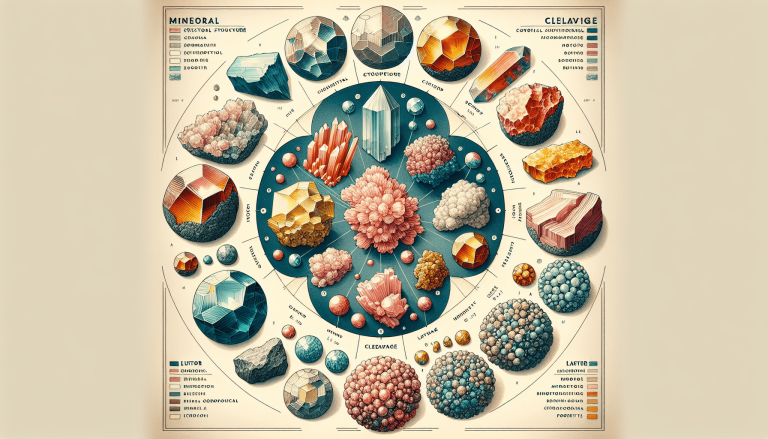Beginner’s Guide To Learning About Mineral Chemical Properties
So, you’re interested in learning about mineral chemical properties… but where do you even begin? Don’t worry, we’ve got you covered! In this beginner’s guide, we’ll take you on an exciting journey into the fascinating world of minerals. From their chemical composition to their unique physical properties, we’ll provide you with all the essential knowledge to understand how minerals are formed and identified. Whether you’re a science enthusiast or simply curious about the world around you, this guide will be your key to unlocking the secrets hidden within these remarkable natural wonders. So, let’s get started on this mineral adventure, shall we?

What are mineral chemical properties?
Definition of mineral chemical properties
Mineral chemical properties refer to the characteristics and behavior of minerals at the atomic and molecular level. They describe the composition, structure, and behavior of minerals, including their elemental composition, chemical formula, chemical bonds, reactivity, and more. These properties are essential for understanding the physical, chemical, and geological aspects of minerals.
Importance of studying mineral chemical properties
Studying mineral chemical properties is crucial for several reasons. Firstly, it allows for the identification and classification of minerals. By analyzing their chemical composition, scientists can determine the specific mineral species present and differentiate between similar-looking minerals.
Additionally, understanding mineral chemical properties helps in comprehending geological processes. Minerals form under specific rock formation conditions, and their chemical composition reveals information about the environment in which they were created. This knowledge aids in reconstructing past geological events and studying Earth’s history.
Furthermore, the economic significance of minerals cannot be overlooked. Minerals are used extensively in various industries, ranging from construction and electronics to agriculture and jewelry. Understanding their chemical properties helps in refining extraction techniques, assessing mineral quality, and predicting potential new sources of valuable minerals.
Lastly, studying mineral chemical properties is crucial for understanding the environmental implications associated with certain minerals. Some minerals can have harmful effects on the environment, such as releasing toxic elements into water sources or exacerbating air pollution. By examining their chemical properties, scientists can devise strategies to mitigate these negative impacts.
Types of properties studied in minerals
Mineral chemical properties encompass a broad range of characteristics. These properties can be divided into two main categories: physical properties and chemical properties.
Analytical techniques for studying mineral chemical properties
To study mineral chemical properties, a variety of analytical techniques are utilized. These techniques provide valuable insights into the mineral’s composition, structure, and behavior. Some common techniques include:
Spectroscopy
Spectroscopy involves analyzing the interaction between minerals and electromagnetic radiation. By measuring the absorption, emission, or scattering of light, scientists can determine the elemental composition and molecular structure of minerals.
X-ray diffraction
X-ray diffraction is a technique used to analyze the crystallographic structure of minerals. By directing a beam of X-rays onto a mineral sample and measuring the diffraction pattern that is produced, scientists can determine the arrangement of atoms within the crystal lattice.
Electron microscopy
Electron microscopy allows for high-resolution imaging of mineral samples. By using a focused beam of electrons, scientists can visualize the surface morphology and internal structure of minerals at the nanoscale, providing valuable information about their chemical composition and crystal defects.
Thermal analysis
Thermal analysis techniques, such as differential scanning calorimetry and thermogravimetric analysis, involve subjecting minerals to controlled heating or cooling while measuring their thermal response. These techniques provide information on phase transitions, thermal stability, and decomposition processes.
Chemical analysis
Chemical analysis involves quantifying the elemental composition and chemical properties of minerals. Techniques such as wet chemical analysis, inductively coupled plasma mass spectrometry, and X-ray fluorescence spectroscopy are commonly used to determine the concentration of various elements present in a mineral sample.
Physical properties of minerals
In addition to chemical properties, minerals also possess various physical properties that can be observed and measured. These properties play a crucial role in mineral identification and classification. Some important physical properties of minerals include:
Color
The color of a mineral is often the first characteristic noticed, but it is not always a reliable indicator of the mineral’s identity. Color can vary due to impurities or external factors such as oxidation or weathering.
Streak
Streak refers to the color of a mineral when powdered. It is determined by rubbing the mineral against an unglazed porcelain plate. Streak color can sometimes be more indicative of the mineral’s true composition than its external color.
Luster
Luster describes the way light interacts with the mineral’s surface. Minerals can exhibit metallic, vitreous (glass-like), pearly, greasy, or silky luster, among others. This property is determined by the reflection and absorption of light by the mineral’s surface.
Hardness
Hardness measures a mineral’s resistance to scratching and is determined by the Mohs scale. Minerals are ranked on a scale from 1 (talc, the softest) to 10 (diamond, the hardest). Hardness can provide clues about the mineral’s composition and structural integrity.
Cleavage and fracture
Cleavage refers to the way a mineral breaks along planes of weakness. Some minerals have perfect cleavage, where they split easily and smoothly, while others have imperfect or no cleavage. Fracture describes how a mineral breaks in a way other than along cleavage planes, such as in irregular or conchoidal (shell-like) patterns.
Specific gravity
Specific gravity is the ratio of a mineral’s weight compared to the weight of an equal volume of water. It provides information about the mineral’s density and can help differentiate between minerals with similar appearances.
Crystal systems
Minerals can exhibit distinct crystal systems based on the arrangement of their atoms. The six main crystal systems are cubic, tetragonal, orthorhombic, rhombohedral, monoclinic, and triclinic. Knowing the crystal system can aid in mineral identification.
Chemical properties of minerals
The chemical properties of minerals reveal important information about their composition and behavior. Some key chemical properties include:
Composition
The composition of a mineral refers to the elements present within it. Minerals can be composed of a single element, such as gold or silver, or a combination of several elements.
Chemical formula
The chemical formula of a mineral represents the elements and their ratios within the mineral. It provides insight into the mineral’s atomic structure and the arrangement of its constituents.
Chemical bonds
Minerals are held together by chemical bonds, which determine their stability and physical properties. Common types of chemical bonds found in minerals include ionic, covalent, metallic, and Van der Waals bonds.
Reactivity
Some minerals are reactive and undergo chemical reactions when exposed to certain substances or environmental conditions. Understanding a mineral’s reactivity can provide insights into its stability and potential uses.
Acid test
The acid test involves applying a small amount of dilute acid, usually hydrochloric acid, to a mineral sample. The reaction, or lack thereof, can help identify certain minerals based on their acid solubility.
Taste and odor
Some minerals possess distinct taste or odor characteristics that can aid in their identification. For example, halite (rock salt) has a characteristic salty taste.

Factors influencing mineral chemical properties
Several factors influence the chemical properties of minerals. Understanding these factors provides valuable context when studying minerals. Some key factors include:
Elemental composition
The presence and proportion of elements within a mineral significantly affect its chemical properties. Different combinations of elements lead to variations in mineral stability, structure, and reactivity.
Crystal structure
The arrangement of atoms in a mineral’s crystal lattice affects its properties. The crystal structure determines characteristics such as cleavage, hardness, and optical properties.
Temperature and pressure
Temperature and pressure conditions during mineral formation can impact their chemical properties. High temperatures and pressures can induce phase changes or promote chemical reactions, altering the mineral’s composition or crystal structure.
Environment of formation
The specific environmental conditions in which minerals form also influence their chemical properties. Factors such as pH, temperature, pressure, and available elements all contribute to the mineral’s composition and characteristics.
Importance of understanding mineral chemical properties
Understanding mineral chemical properties is crucial for various reasons. Some of the key importance includes:
Identification and classification of minerals
Mineral chemical properties are vital for identifying and classifying minerals. By analyzing their composition, formula, and other chemical characteristics, geologists and mineralogists can accurately determine the mineral species present.
Understanding geological processes
Minerals provide essential clues about the geological processes that have occurred in an area. By studying their chemical properties, scientists can uncover information about past environments, tectonic activity, and even the presence of valuable resources.
Economic significance
Minerals play a significant role in the global economy. Understanding mineral chemical properties is essential for mineral exploration, extraction, and refining processes. It helps optimize resource utilization and identify potential new sources of valuable minerals.
Environmental implications
Minerals can have both positive and negative environmental implications. Understanding their chemical properties enables scientists to assess the potential for environmental harm, develop responsible mining practices, and minimize the impact of mineral extraction on ecosystems.
Examples of mineral chemical properties in practice
Mineral chemical properties are applied in various practical contexts. Some examples include:
Identifying mineral composition in ore deposits
Understanding the chemical composition of minerals within ore deposits is crucial for efficient mining and extraction processes. By analyzing mineral chemical properties, geologists can determine the feasibility of extracting valuable elements and ensure proper resource management.
Determining the origin of gemstones
Gemstones derive their value from their rarity, beauty, and unique chemical properties. By studying the chemical composition of gemstones, including trace elements and impurities, gemologists can determine their origin and authenticity, crucial information for gemstone buyers and collectors.
Characterizing mineral formations in geological studies
Mineral chemical properties aid in characterizing and interpreting mineral formations. By analyzing minerals in a particular geological context, scientists can gain insights into the processes that formed the rocks, reconstruct ancient environments, and understand the evolution of Earth’s crust.
Resources for learning about mineral chemical properties
Several resources are available for individuals interested in learning about mineral chemical properties:
Textbooks and reference books
There are numerous textbooks and reference books dedicated to mineralogy and mineral chemistry. These resources provide comprehensive information about mineral chemical properties, analytical techniques, and their applications.
Online courses and tutorials
Online platforms offer a wide range of courses and tutorials on mineralogy and mineral chemistry. These resources provide interactive learning experiences and cover topics from basic mineral identification to advanced chemical analyses.
Mineralogical societies and organizations
Mineralogical societies and organizations, such as the Mineralogical Society of America and the International Mineralogical Association, provide valuable resources for individuals interested in mineral chemistry. They offer publications, conferences, workshops, and networking opportunities.
Field trips and hands-on experience
Field trips to mineral-rich areas and hands-on experience with mineral samples can enhance learning about mineral chemical properties. Visiting museums, geological sites, or participating in mineral collecting can provide practical insights into mineral identification and properties.
Challenges in studying mineral chemical properties
There are several challenges inherent in the study of mineral chemical properties:
Accessibility to samples
Obtaining representative samples of minerals for analysis can be challenging. Some minerals are rare or occur in remote locations, making it difficult to obtain sufficient quantities for comprehensive study.
Complexity of analytical techniques
Many analytical techniques used to study mineral chemical properties require specialized equipment and expertise. Understanding and operating these analytical instruments can be challenging for beginners.
Interpreting data accurately
Analyzing and interpreting mineral chemical data accurately requires knowledge and experience. It can be challenging to discern important patterns and extract meaningful information from complex datasets.
Variability within mineral species
Mineral properties can vary significantly within a single mineral species. Factors such as impurities, crystal defects, and environmental influences can affect a mineral’s chemical properties, making it challenging to establish definitive characteristics for every individual specimen.
Future directions in mineral chemical properties research
Mineral chemical properties research continues to evolve, driven by advancements in technology and a growing understanding of minerals. Some future directions in this field include:
Advancements in analytical techniques
Continued advancements in analytical techniques will enable more precise and comprehensive analysis of mineral chemical properties. New instruments and methodologies will provide deeper insights into mineral composition, structure, and reactivity.
New discoveries and mineral identification methods
Ongoing exploration and scientific research will likely lead to the discovery of new minerals or previously unrecognized properties of known minerals. These discoveries will contribute to expanding our knowledge of mineral chemistry and enhance mineral identification methods.
Integration of mineral chemistry with other scientific fields
Mineral chemistry is interrelated with various scientific fields, including geology, geochemistry, materials science, and environmental science. Future research will focus on integrating mineral chemistry with these fields to gain a holistic understanding of Earth’s processes, material properties, and environmental impacts.
In conclusion, understanding mineral chemical properties is essential for a comprehensive study of minerals. It involves analyzing their composition, structure, and behavior at the atomic and molecular level. By studying mineral chemical properties, scientists can identify minerals, understand geological processes, and assess economic and environmental implications. Various analytical techniques are employed, including spectroscopy, X-ray diffraction, electron microscopy, thermal analysis, and chemical analysis. Physical properties, such as color, streak, luster, hardness, cleavage, fracture, specific gravity, and crystal systems, also play a crucial role in mineral identification. Challenges in studying mineral chemical properties include sample accessibility, analytical complexity, data interpretation, and variability within mineral species. However, with advancements in technology and continued research, the field of mineral chemical properties will continue to expand and contribute to our understanding of minerals and Earth’s processes.







